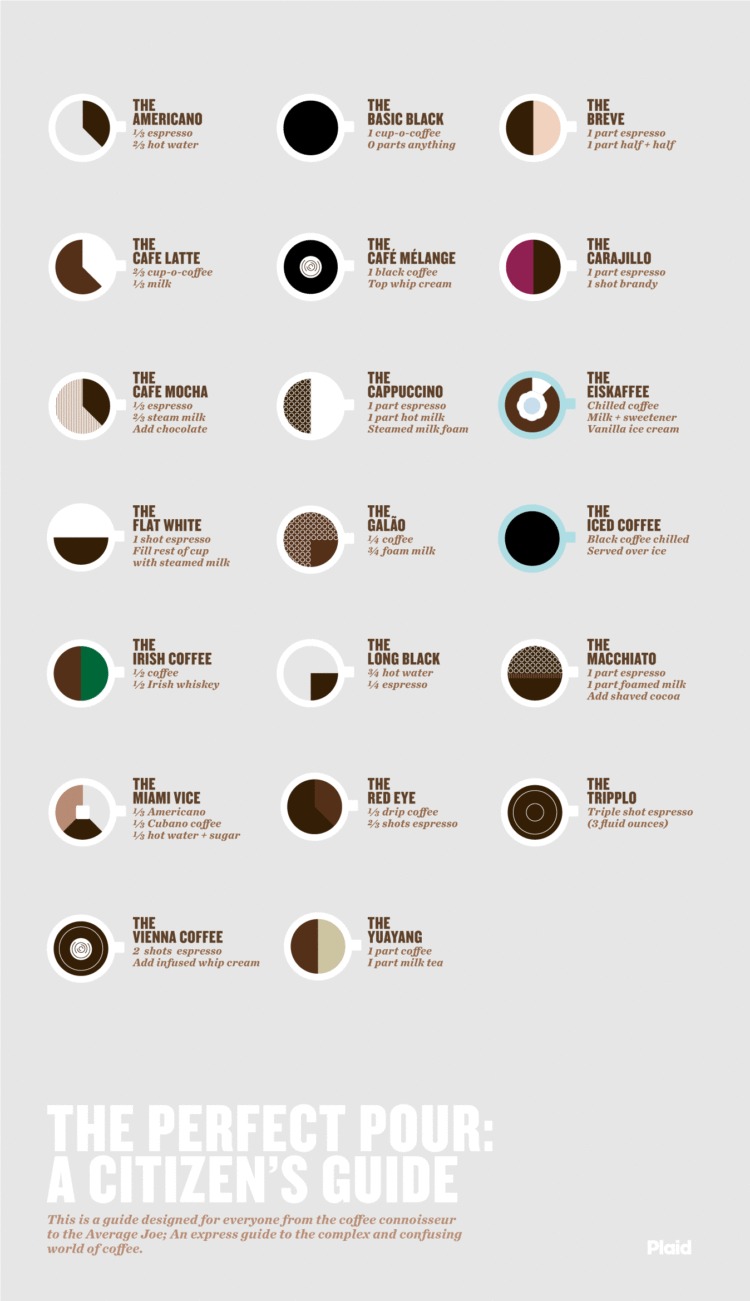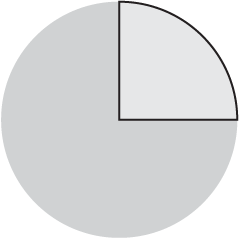In the same spirit of the original coffee drink infographic from a few years ago, Plaid Creative describes the perfect pour, or as I like to call it, the citizen’s guide to fancy pants coffee drinks. At its root, its a series of pie charts where each wedge represents the percentage of ingredient in a given fancy pants drink. But the subtle stylings make it look so much more delicious, from the pattern fills out to the mug-like border.
[via thisisnthappiness]




You are missing one crucial entry: Café Brutal – Coffee without cognac… ;-)
I think I prefer the style of graphic that shows the cups side-on, it can illustrate the relative volumes of some of those drinks more clearly. Ugly example here: http://www.eatallaboutit.com/wp-content/uploads/2009/06/coffee.jpg
Oh, and as an Irishman I should point out that there’s a bit more to an Irish Coffee than just coffee and whiskey – you need fresh cream and brown sugar too.
Really excited to note that there is a cup of YuaYang!. A Hong Kong original!
I know this is a little tongue-in-cheek, but I shall criticise it regardless.
1. I believe the guide would work much better with percentages rather than (super) complicated fractions, being basically a ‘sexy’ pie chart.
2. The units used must be consistent. I don’t know hat a half and half is…
3. Define ‘cup’.
Finally, are there *really* cups of coffee with alcoholic beverages in them?
Yannis, “half and half” is a dairy product and not a measurement. It’s one part milk to one part cream, and in the USA one buys it in the dairy section of a grocery store.
My first response is to also want the recipes depicted from the side, so as to show a better sense of volume – as I did this same thing while working in a coffee shop right out of college. But if you think about it, In many cases it isn’t necessary (e.g. if you make an Americano in a 4oz. mug or a 32oz. jug, it doesn’t change the ratio). However, some of the recipes could arguably benefit (e.g.the Carajillo would need more than a single shot if you were to use a larger container and therefor a larger ‘part’ of espresso).
I also think there is some confusion between the written components and the illustrated in some examples (e.g. the Eiskaffee neither explains in the writing how much of each ingredient, nor does the illustration adequately explain which portion belongs to which ingredient; particularly the sweetener)
• I agree on the percentages over fractions, though I am willing to admit that it is partially a personal choice as I think…
• …the units are generally consistent. In as much as a ‘part’ can be consistent. Half & half isn’t a unit, it’s an ingredient. In the United States at least, ‘half & half’ is typically an equal mix of milk and cream, pre-mixed and sold in stores. Admittedly a possible issue internationally.
• Without any further clues, we could take cup literally, as a unit of measure. http://en.wikipedia.org/wiki/Cup_(volume)
Lastly, of *course* there are cups of coffee with alcohol.
i like the graphics even though they totally ignore the size of the vessels that type is usually served in. which is highly irritating.
and the recipes.. i wont comment on those, because cooking is a very local thing. and coffee is even more special – just as a reference, here is what i call a Café Latte: http://www.ipernity.com/doc/grubernd/8030374 – selfmade and i usually have at least two of those per day. :)
There’s yet another similar infographic about halfway down The Oatmeal’s humorous “15 Things Worth Knowning About Coffee”
http://theoatmeal.com/comics/coffee
Wow, what a popular topic for such graphics!
Pingback: The Perfect Pour Diagrams The Ratios Of Fancy Coffee Drinks | Lifehacker Australia
This is an awesome idea!
One thing though, what you have down as The Cafe Latte is actually Cafe-au-Lait, which is entirely different.
A Latte is 1/3 espresso, 2/3 steamed milk, topped with foamed milk.
With a little work and a few corrections you’ll make a fortune selling this as a poster…
Glad someone else noticed that. :)
If you’re going to go to all the trouble of making the graphic look pretty, why on earth would you not check the spelling before publishing?
Either translate it all into English, or spell the Italian (e.g. “caffè”, “triplo”) correctly.
For all you pie chart haters… It’s not a pie chart. It’s supposed to be a coffee cup, see the handle. I do wonder how many people short-circuited to pie chart hating and disregarded the authors attempt. At first, I know I did, but I like the coffee cup attempt because we mostly see our coffee by looking down into the cup – like the graphic.
Sure, we don’t see what it looks like, but I give the author props for trying.
On a different note:
I moved to Australia for a year and they do not have drip coffee/percolator coffee/standard American coffee except in a few places. They have an espresso machine w/ all the variations and The Long Black and The Flat White are the daily “coffee”. One year later, I still didn’t get over that culture-shock.
Great post! Now I have a guide when I go to coffee shops that has far too confusing coffee names. Sometimes the baristas are too busy to explain to me the coffee contents, so this is a big help. Time to put my cup coffee maker to rest and head out to Starbucks. Thanks for the help
Pingback: Link(s): Mon, Jul 19th, 1pm | Your Revolution (The Blog!)
A macchiato in this part of the world is a shot of espresso, ‘stained’ with milk (usually steamed).
They manage to break out two acute accents and a tilde, but they can’t bother to put the rest of the accents in or fix “I part milk tea”? Do they take no pride in their work?
i want this as a big A1 poster to put on my wall in respect/adoration!!! for the artist, and for all things derived from our friend the coffee bean!!!
Ah, yeah, barista here, worked on three continents. The majority of the ratios/definitions here are wrong. I don’t understand why – the research surely not hard to do, and the creator is clearly not untalented, so…?
It’s also not a real logical way to do it, because the recipes of espresso-based drinks start with the espresso. 1 or 2 shots of espresso, and then various amounts of steamed milk/foam/hot water.
Alcohol is also usually measured in standardised shots.
all of which is a pity because the chart is pretty!
Also, I’m not sure what is meant by the fractions – eg. Americano: 1/2 espresso, 2/2 hot water? does that mean the cup overflows? Or that the first of two parts is espresso, the second of two parts is hot water – but then some of the others don’t make sense…
Pingback: Is drinking too much tea bad for me as a teen? | tea house
New theory:
There are too many distinct types of mistakes for this to just be sloppy work: graphic errors, typographic errors, factual error—you name it, it’s here. This must be a nerd snipe by Plaid Creative.
Thanks EVERYONE, we appreciate the corrections.
Several variations on recipes have been floated to us from all over. We will try to incorporate as many as possible into a happy medium soon.
Either way, thanks for the interest in our design, we’ll be having them printed in the near future. You can check back with our blog if you’d like to see our progress or get a copy.
http://blog.plaid-creative.com
1 up on Yua Yang.
Pingback: Coffee Spoons › Coffee Flavoured Coffee
Wow, interesting. Just saw this on a design blog. But, as my comment still holds, a cross-post is in order:
As per the many comments on the site, there are quite a few errors, unfortunately. And it’s pretty far from informative, as the same ingredient changes colors across drinks. Note the top-left three (Americano, Basic Black, & Caffe Latte) for an easy example.
Visually interesting, but doesn’t stand up to scrutiny.
Pingback: Ideetjes « Hoe kan iks…
i mostly just browsed the comments, so if i repeated anything, sorry, but…
what is described as a latte, is actually a cafe aulait, what is described as a cappuccino is actually a latte, and pretty much so is the flat white. and a long black is described as an americano, but it’s different. wikipedia can set you straight.